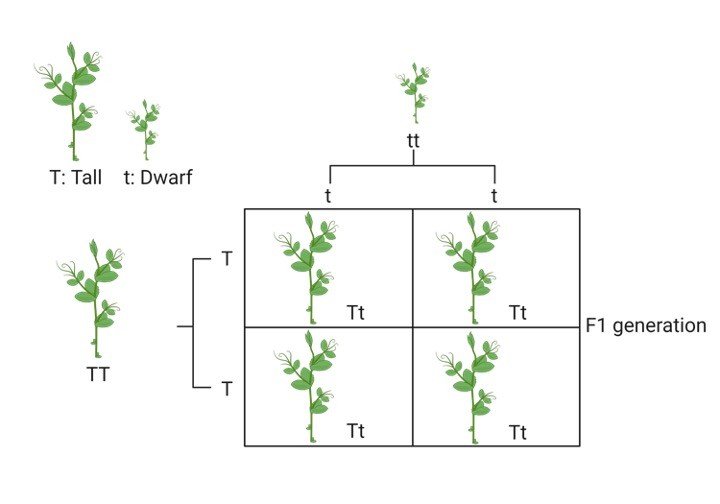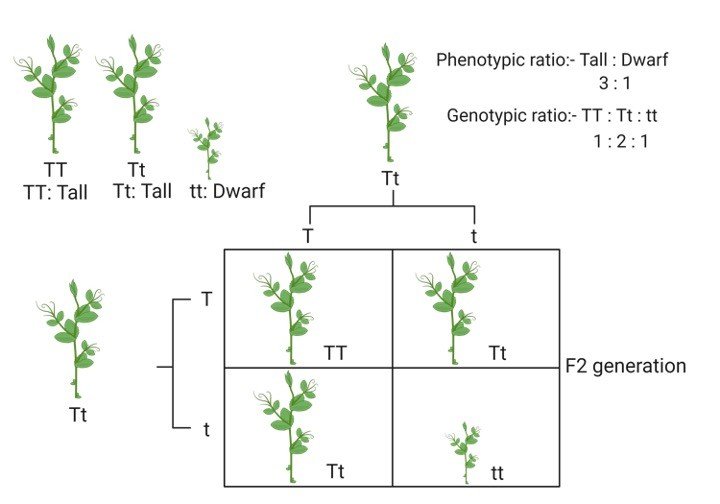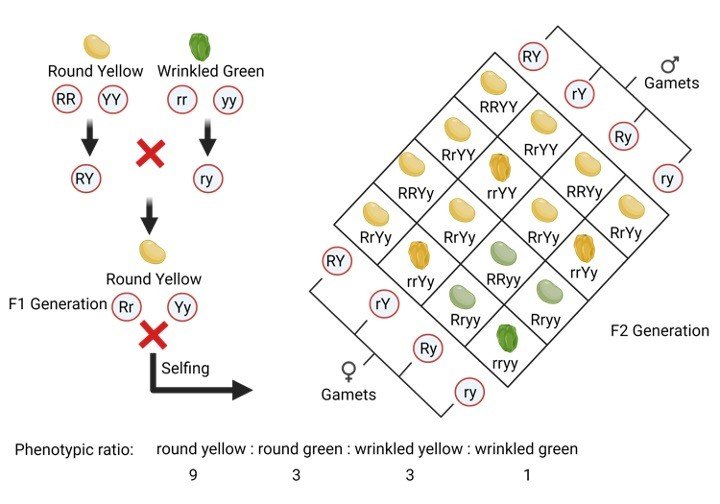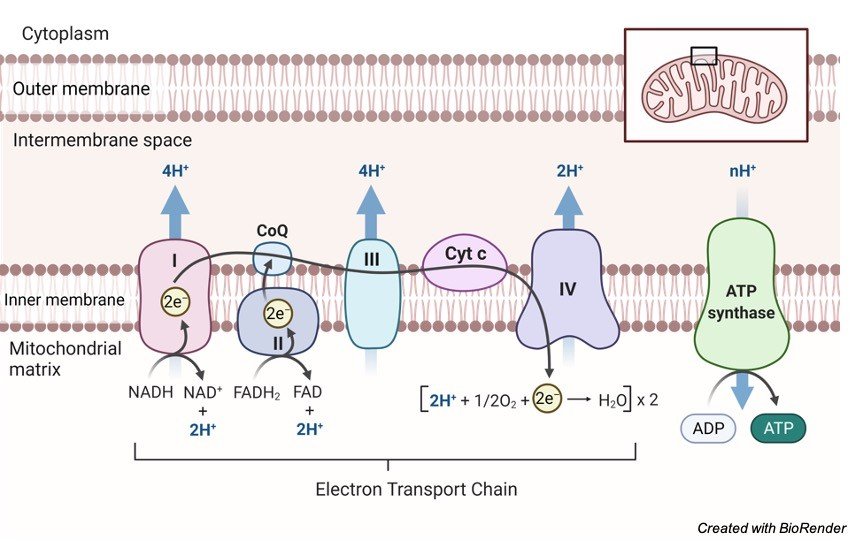What is Mendel's Laws of Inheritance or Mendelian genetics?
Mendelian genetics or Mendelism or Mendelian inheritance is a pack of primary tenets that are affiliated to the relaying of hereditary features from parent organisms to their kids; it is nothing but due to the genetics.
These tenets were originally extracted from the study of Gregor Mendel published in the year 1865 and 1866, which was founded in 1900.
It was originally controversial, however later it became core of classic genetics.
Historical Facts About Mendel's Laws of Inheritance
Credit of laws of inheritance goes to Gregor Mendel, a monk of nineteen century who performed experiments on hybridization in peas (Pisum sativum).
Between 1856 and 1863, he grew and tested around 28,000 pea plants and from this he deduced two generalizations that became famous as Mendel’s Laws of Heredity or Mendelian inheritance.
This is delineated in two sections of the research paper “Experiments on Plant Hybridization”, that was published in the journal in the year 1866.
What is Inheritance?
Inheritance can be defined as the procedure of how a child receives genetic information from the parent.
This process of hereditary is related to the dependence which gives the offspring same trait as of parents.
Inheritance is which is why, the family members have similar and distinctive features.
Why Mendel Choose Pea to Study Genetics?
He chose pea for his experimental procedures because it can be grown easily and are naturally self-pollinating.
Pea plant not only can be self-pollinated but also can be cross-pollinated.
It is yearly plant, ergo, many generations can be followed in less duration of time.
Not only this it also possesses contrasting traits.
Mendel's Laws of Inheritance
The two majors’ experiments done by Mendel to establish the laws of inheritance (Mendel’s Laws of Inheritance) were:
1. Monohybrid Cross Experiment
2. Dihybrid Cross Experiment
During his procedure he found that many features and traits passes to the offspring in a stable way.
These factors are known as genes. Unit of inheritance is nothing but genes.
Mendel’s Experiments
He conducted experiments and contemplated seven major contrasting features in the plants.
Then, he conducted both the experiments to determine the aforementioned inheritance laws.
1. Monohybrid Cross
He took two plants of pea with contradictory traits that is one short and one tall and then crossed them.
It was noticed by him that the offspring’s of the 1st generation were tall and he termed it as F1 progeny.
Then he crossed F1 progeny which yield him tall as well as short plants in the ratio 3:1.


Mendel even did experiment with other contrasting features like green peas vs yellow peas, round vs wrinkled, etc. and he found that the results were the same.
This led to the discovery and the formulation of the laws of Segregation and Dominance.
2. Dihybrid Cross
Mendel in his dihybrid cross trial he took two traits, each having two alleles and then he crossed wrinkled-green seed and round-yellow seeds and noticed that all the first generation progeny (F1 progeny) were round-yellow.
He therefore concluded that the dominant traits were the round shape and yellow colour.

He also self-pollinated the F1 progeny and got 4 different features like wrinkled-yellow, round-yellow, wrinkled-green seeds and round-green in the ratio 9:3:3:1.
Mendel's Laws of Inheritance
Mendel postulated three laws, which are now called after his name as Mendel’s laws of heredity.
1. Law of dominance
2. Law of segregation
3. Law of independent assortment
1. Law of Dominance
When two homozygous individuals with one or more sets of contrasting characters are crossed, the characters that appear in the F1 hybrids are dominant characters and those do not appear in F1 are recessive characters.
The dominant and recessive traits of the genes can be dependent on the enzymatic function of the genes of which dominant genes can make functional enzymes which synthesize active polypeptides or proteins.
On the other hand, the recessive genes (mutant genes) code for incomplete or non-functional polypeptides.
Therefore, the dominant genes make a distinct phenotype which can be expressed even in the heterozygous condition while the recessive cannot make so.
Researchers undertook various cross-breeding experiments to authenticate applicability of law of dominance like Correns on peas and maize, Tschermak on peas, and many others.
They discern plenty of characters in several life form is related as dominant and recessive.
Importance of Law of Dominance
In the hybrid trait the normal characteristics shown by dominant gene reveal significant advantages over the dreadful characters exhibited by recessive gene.
It was noted that diabetes, hemophilia etc. are all traits of recessive characters.
A hybrid person may possess all these characteristic in addition to this recessive gene can persist for next several generations without expressing themselves.
In contrast, there is exception to Law of Dominance which is known as Incomplete Dominance.
Mendel was followed by several scientists in case of blending of characters of two parents.
This trait shows characteristics which are amalgamated from both the parents with both sets of genes which is commonly known as incomplete dominance or blending inheritance.
It is the result of expression of genes partially from the dominant trait and partially from the recessive one.
For example, in four O-clock plant, Mirabilis Jalapa, red (RR)flower plant is crossed with white (rr) colored plant resulting in plant with pink (Rr) color flower.
On self-pollination with pink color flower the ratio of getting red (RR), pink (Rr) and white (rr) is 1:2:1.
2. Law of Segregation (Purity of Gametes)
This law states that when trait of two opposite genes or allelomophs are mixed together the resultant pair stays without being contaminated while gametes separate out from each other and only one enters each gametes.
As a result, two types of gametes are produced from the heterozygote in equal numerosity. 50% of the gametes possess gene T and other 50% possess gene t.
Importance of Law of Segregation
According to cytological studies, the law of segregation holds good to all cases whether it is dominance or no dominance.
Rare biological generalization has made its applicability far out reaching.
3. Law of Independent Assortment
In this law, the study of inheritance of more than one pair of characters is carried our simultaneously, wherein the factors or genes can be sorted independently from its correspondent allele.
Based on the result of dihybrid cross, Mandel formulated Mendel’s Laws: Independent Assortment .
Importance of Law of Independent Assortment
Various cytological studies revealed that those allelomorphs which are assorted independently during cell division, are actually located on different homologous pairs of chromosomes.
However, if the traits for various characteristics are seen on the same homologous pair of chromosomes, these are passed on to the same gamete.
This law fails on its universal applicability.
Biological Significance of Mendel's Laws
Mendel’s work unfolded after 3 decades of his actual work and the laws he mentioned was widely used by various branched for the purpose of scientific evaluation.
Many modern genetic modification was seen like getting rust-resistant and disease-resistant varieties of grains and for breeding high grade variety of horses and dogs.
The science of segregation is the outcome of Mendelism, which deals with the betterment of human race.
Conclusions from Mendel’s Experiments
Genotype is defined by the genetic makeup of the organism while phenotype is defined by its physical appearance.
The genes are transmitted from parents to offspring and is called as allele.
There is a 50% chance of one of the two alleles to fuse with the other parent during gametogenesis when the chromosomes are halved.
When the alleles are the same, they are known as homozygous alleles and when they are different they are known as heterozygous alleles.
Mendel’s law benefited the humankind by generating high grade breed of various plants and animals.
Moreover, they have higher implication in diagnosing and preventing various genetic disorders.
Mendel's Laws of Inheritance Citations:
- Mendel’s laws, Mendelian randomization and causal inference in observational data: substantive and nomenclatural issues. Eur J Epidemiol . 2020 Feb;35(2):99-111.
- Limits of imagination: the 150th Anniversary of Mendel’s Laws, and why Mendel failed to see the importance of his discovery for Darwin’s theory of evolution. Fly (Austin) . Jan-Mar 2013;7(1):28-38.
- Mendel’s law reveals fatal flaws in Bateman’s 1948 study of mating and fitness. Fly (Austin) . Jan-Mar 2013;7(1):28-38.
- ‘Rediscovery’ revised – the cooperation of Erich and Armin von Tschermak-Seysenegg in the context of the ‘rediscovery’ of Mendel’s laws in 1899-1901. Plant Biol (Stuttg) . 2011 Nov;13(6):835-41.
- Historical study: Johann Gregor Mendel 1822-1884. Am J Med Genet . 1991 Jul 1;40(1):1-25; discussion 26.
- A female contribution to early genetics: Tine Tammes and Mendel’s laws for continuous characters. J Hist Biol . Fall 1995;28(3):495-531.
Share









